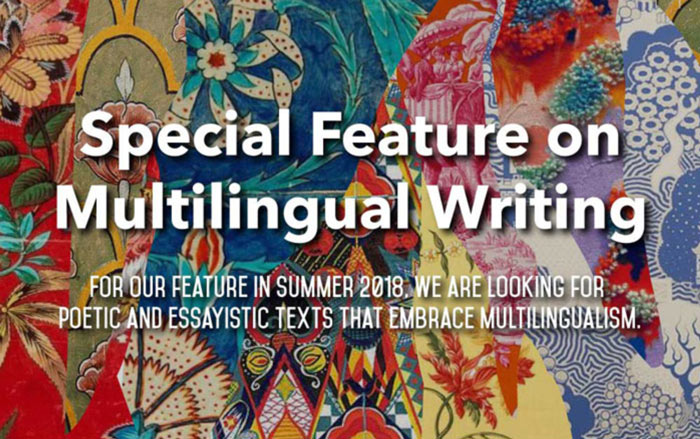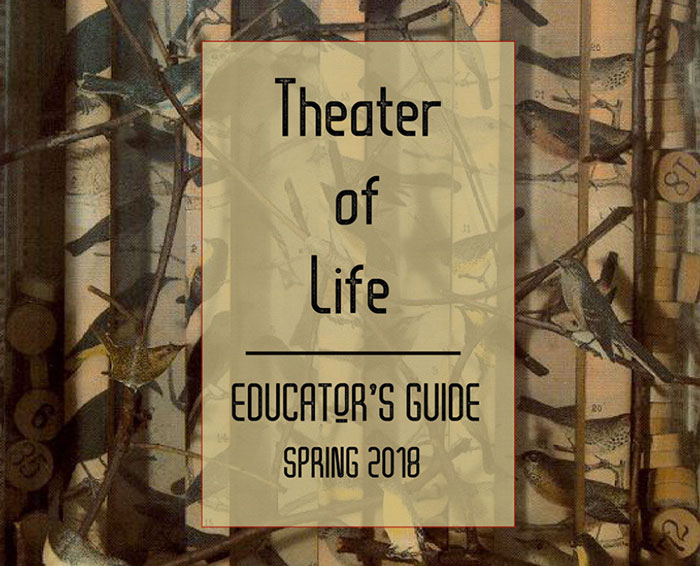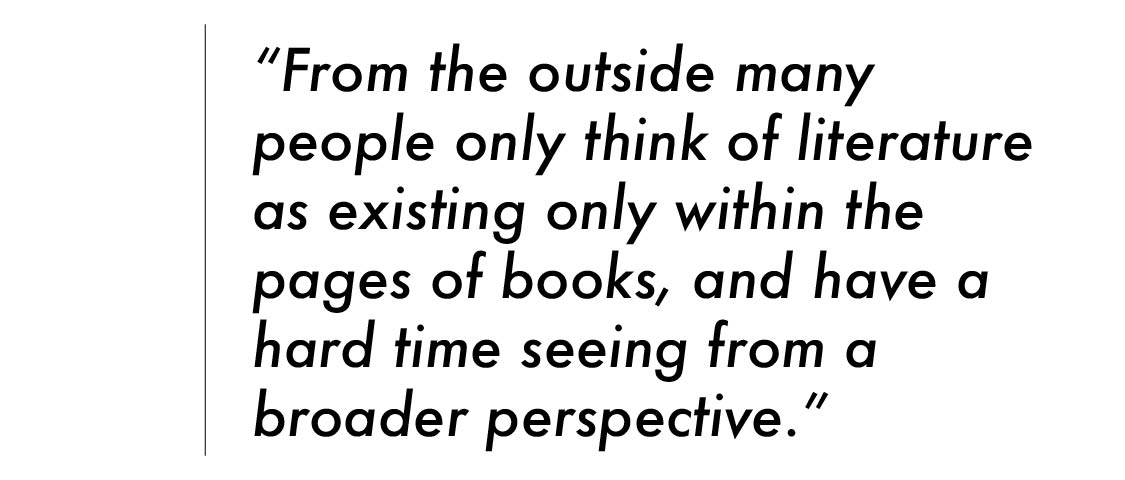|

Our Special Feature on Multilingual Writing returns this summer! We seek poetry and nonfictional texts that, to borrow a Chinese idiom, straddle at least two boats with one pair of legs. After checking out our previous two Multilingual Special Features in our Summer 2015 and Summer 2016 issues, find our submission guidelines here and send us your best salmagundi.

For all you teachers out there: the Spring 2018 Educator’s Guide is now available for download here! Visit the Asymptote for Educators web page to discover new ways to bring translation into your classroom. With writing prompts and reading suggestions galore, this guide will be sure to spice up any literary discussion. Share the wealth with all your educator friends and be sure to fill out this survey to give us feedback about o ur Guides! Your feedback is invaluable in helping us introduce world literature into the beautiful young minds of the world.

In this conversation with Assistant Interview Editor Claire Jacobson, Paul Worley discusses the complications in translating and publishing multilingual literature. Worley earned his Ph.D. in Comparative Literature from the University of North Carolina-Chapel Hill, and is currently in Mexico with the support of a Fulbright-García Robles U.S. Scholars grant to research English as a Second Language and the Tsotsil language. His translation of Xtámbaa/Earthen Skin by Hubert Matiúwàa (also known as Hubert Malina) from Spanish and Mè’phàà appeared in Asymptote in the Winter 2018 edition.
You worked with both the Spanish and Mè’phàà texts to produce your English translations. Can you talk about that experience, and the challenge of translating from a language that is unfamiliar to you?
Not having studied or worked in Mè’phàà previously, I relied extensively on the Spanish text and the author's notes. I was in close contact with the author about any questions I had concerning his own translation, as well as metaphors or turns of phrase I had doubts about.
I've studied other Mesoamerican languages (Yucatec Maya and Tsotsil), so on the one hand I'll confess to being ambivalent about my relying too heavily on the Spanish to translate these poems. While a lot of cultural content may already be lost moving across Mè’phàà/Spanish, translating that into English without knowledge of Mè’phàà was a different experience in that as I put the poems in English I was only dimly aware of “what I didn't know.”
On the other hand, I feel the social and political claims of these and so many other works demand immediate attention from a global audience. My not knowing Mè’phàà is already part of the problem, and yet I don't think my own inadequacies are an excuse to ignore that fact that these poems deserve to be translated and Malina's voice deserves to be heard. As a translator, it would be something of a dream if one day someone who can work across all three languages were to come along and criticize my translations. After all, that would mean that Mè’phàà was continuing to thrive in the “global village,” and that's one of the primary aims of Malina's work.
At some places in the Spanish and English versions, a few Mè’phàà words remain. Whose choice was it to leave them in the original language, and what was the desired effect of that choice? Similarly, some are explained with a translator’s note, and others are not. How did you decide what to explain and what to leave alone?
I followed Malina's lead by only translating into English what Malina had already rendered in Spanish. There is already a lot of tension between the Mè’phàà and Spanish texts both in terms of what is translated and what isn't, and I hope that the decision not to translate some words, and furthermore not to provide footnotes for certain words, recreates that tension once again in English and forces the reader to think of Mè’phàà as a living language. It's something of a scholarly debate at the moment as to whether people even read the Indigenous language in bilingual texts, or if those texts serve only to vouch for the author's membership in a particular language group. While I respect the fact that yes, speaking an Indigenous language is popularly construed as signaling membership in a particular language group and yes, most people will indeed only read the Spanish language text, none of this means that the Indigenous language text can't be read. It obviously can. Not translating thus becomes a way to encourage the reader to admit that, even in translation, she must come to terms with her own linguistic and cultural limits, and that more work and attention will be required to gain a deeper understanding of the text.

You mentioned in your translator’s note that Xtámbaa is the first Mè’phàà poetry collection ever published. What is the significance of these poems first entering the world through Mè’phàà, rather than Spanish, and how does it fit into the corpus of Mè’phàà literature?
It's important to note that in 21st century Mexico, bilingual publication in Spanish and an Indigenous language is in many ways a precondition of Indigenous writing, though certainly not always. This is as much due to the fact that the Mexican state tends to patronize Indigenous authors as it is because those authors want to reach a national, if not international, audience. These writers are also usually their own translators between their own language and Spanish. Importantly, Spanish is also the primary means of communication among authors from different language groups, so many Indigenous authors also claim Spanish as a language of literary production. In many senses, these poems were born simultaneously in both. The Yucatec Maya poet Briceida Cuevas Cob talks about her poems as having two hearts, one in each language.
When dealing with Indigenous languages, it's essential to realize that they frequently operate from a distinct understanding of text. For example, the Kamënstá poet Hugo Jamioy believes that illiteracy in the Américas is a two-way street, with non-Indigenous peoples being as illiterate in Indigenous writing systems as many Indigenous peoples are in alphabetic script. In that sense, an object like a Kamënstá chumbe or a Cherokee wampum belt can be used to narrate a story to an audience in much the same way that you can deliver a story by reading a book aloud. That's a roundabout way of saying that I have no doubt that the kinds of discourse and turns of phrase Malina uses straddle the book and different kinds of text, ceremonial and otherwise, that situate it within a larger Mè’phàà literary culture. The problem in many ways is that from the outside many people think of literature as existing only within the pages of books, and have a hard time seeing from a broader perspective.
Given the fluid notion of what constitutes a text in Indigenous literatures, what place is there for translation among these forms, languages, and concepts of meaning?
I think that translation takes center stage in a number of different ways that a lot of folks tend not to consider when thinking of literary translation. For example, the Popol vuh or Popol wuj, a K'iche' Maya sacred text, is certainly a text that one can sit down and read in English translation. On one level, you also have to remember that the text you are reading is the transcription of a particular performance of a pre-Hispanic Mayan codex. That is, what you are reading is not a translation of an original text but a translation of a transcription, which itself is an attempt to translate oral performance into writing. On another level, your own reading of the text is in some sense a translation from the process by which this text was meant to be read. You are likely reading alone, quietly, and to yourself, as opposed to in a community, aloud. These complications are only deepened when you consider the relationships many Indigenous texts explicitly bear to texts that we don't think of as necessarily literary, such as the earlier mentioned textiles. To some extent, I think what’s necessary, and what these texts are creating a space for, is an awareness of the totality of what is being translated—an awareness that extends far beyond the text at hand. In many cases, these works are pushing for a much more inclusive definition of text and literature.
Find Paul Worley's translation of Xtámbaa/Earthen Skin by Hubert Matiúwàa in our Winter 2018 edition here.
|